https://www.youtube.com/watch?v=sDQeHCryXmo
How To Grind Every Spice _ Method Mastery _ Epicurious
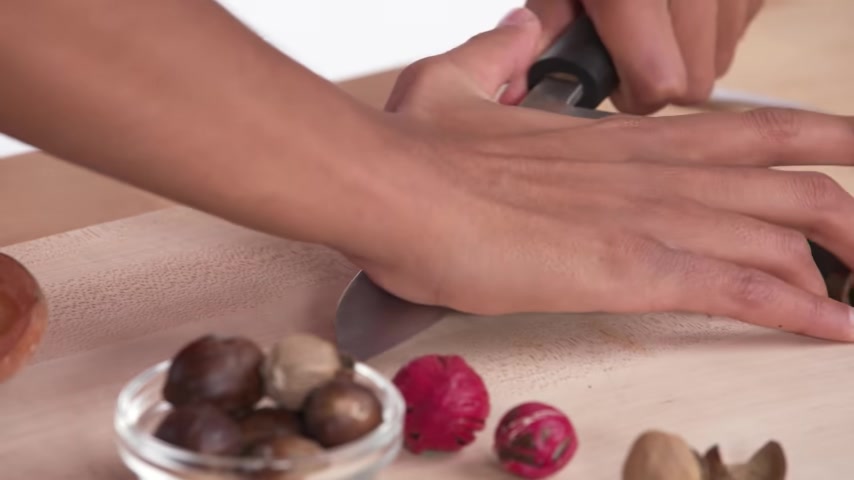
I'm , I'm the founder of Dias and I'm gonna show you how to grind every spice .
I'm gonna show you the plant that originally comes from and then how that transforms into the spice that you see and recognize at the grocery store every day .
These are peppercorns .
They are the fruit of the flowering pepper vine .
The black pepper vine essentially grows around a more stable tree .
And in the spring , that vine will start to bear pepper berries which will be green as they're unripe .
And then as they ripe in will change from red all the way to like a deep dark purple .
A peppercorn is then actually that fruit that is harvested , roasted , threshed and sun dried for 5 to 6 days .
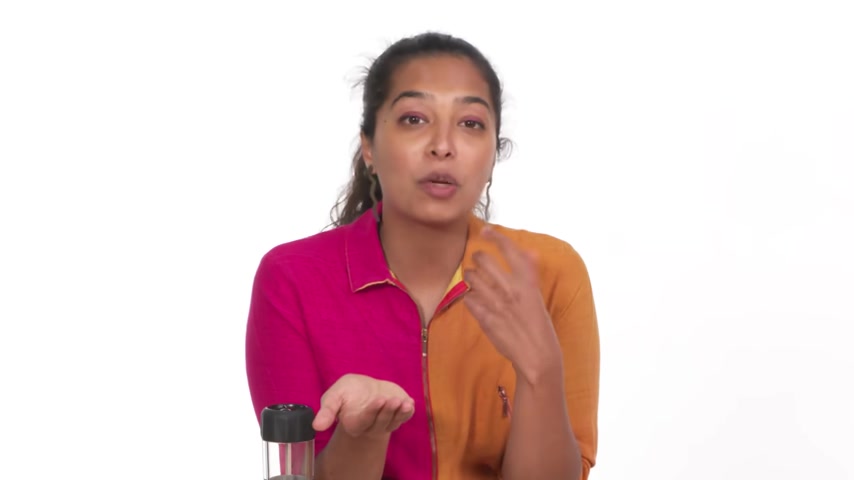
And then what you end up with are these beautiful dark red purple , black and gray , inky colored little dried fruits .
It is interesting to think of a peppercorn as a dried fruit because a good peppercorn should have a significant fruity flavor before you hit the inner part of the seed .
At which point you're getting the spice and the sharp pepper flavor that you know , black pepper is specifically indigenous and known to be from the ancient coast of Kerala .
Most of the flavor of your pepper will be released in the oil within minutes after you grind it , which is why a pepper mill and freshly ground black pepper is the only way to go .
It's possible to be a spice expert and still make tremendous mess .
All you really got to do is freshly grind into whatever you're making oils within each pepper .
Berry are not just being released into the air , but it's also distributing the oils evenly throughout the berry and into this bowl .

The white is the inner seed of the pepper berry .
And that's what has all the pipe and content , which is the spicy stuff that you feel in your tongue .
But then the black bits are actually the dried berry , which makes the fruit part of it .
And when you're grinding it , you're getting both perfectly blended together .
So you're getting that mix of sweet and spicy and jammy and crisp .
So this black pepper was ground just a few moments ago and already I can tell that it's lost a significant amount of its aroma .
So it really speaks to why freshly ground black pepper is the only way to go .
And that pre ground stuff is just , it's not an option .
This is the nutmeg fruit as it would be when it's just picked off of the tree .
There's some plants that actually give you two spices from one plant .
So in this case , the nutmeg itself is the nut in here .
It's surrounded by the mace arrow .
Arrow is a fancy word for a seed covering .
So this red beautiful stuff is the mace that we would then peel off .
So that's our mace .
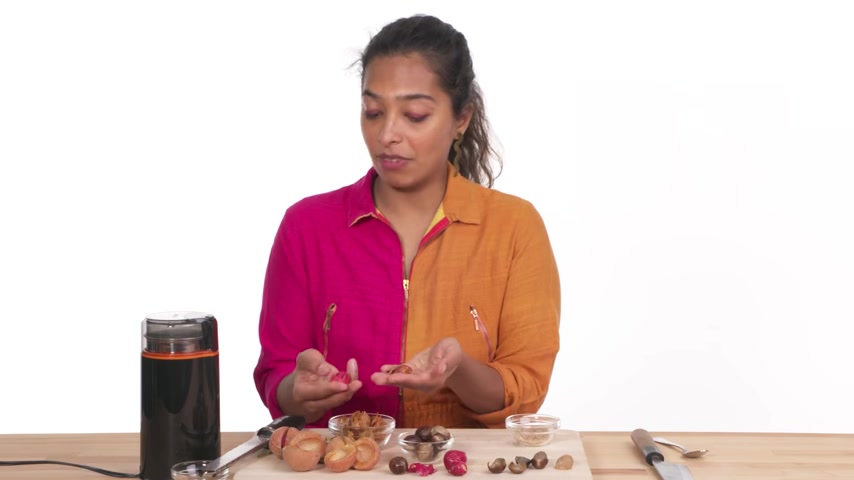
And then this is actually shelled nutmeg .
So what I'm gonna wanna do is crack this open , ungraded .
The shelled nut mic actually doesn't have a ton of aroma .
The magic of micro planting fresh nutmeg is that you're unlocking those essential oils that are in here , right when you want to eat and right when you're gonna get the most flavor out of it , the smell is hitting me .
It's magical .
It smells like Christmas .
So this is our fresh mace where you see that it's thick , wet , glossy , bright red and then when it's correctly , really gently dried , you have a little bit of yellowing and golden at the edges because the mace is quite so delicate .
It doesn't make for very easy grating and even in a mortar and pestle , you'd have kind of a hard time catching it , which is why I think the ease of a spice grinder , especially an electric one is the way to go for mace and we need a few seconds max to get these really nicely ground .
Can you see that color ?
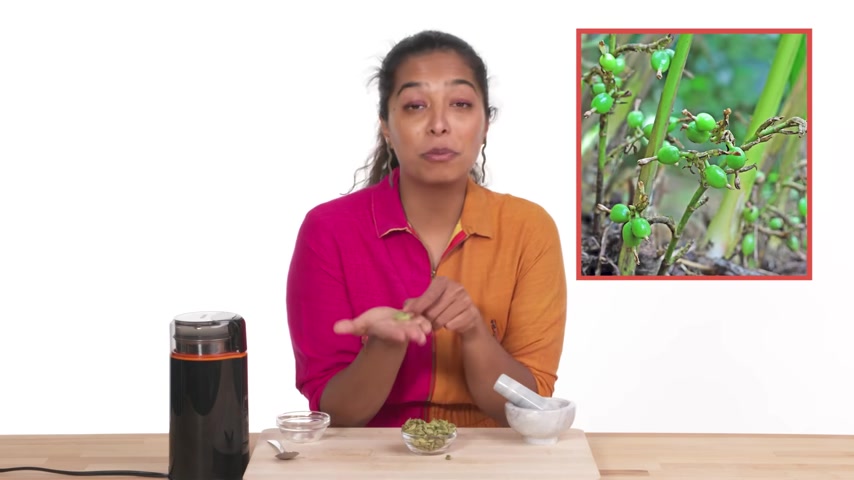
You really wanna use this immediately in very small doses when it comes to mace .
Much more fruity floral notes .
There's a raw mango sourness .
There's a fruity papaya flavor , fresh sug nutmeg has these beautiful tasting notes of kind of menthol lemon grass , a little hint of tobacco .
There's an edge to nutmeg .
There's something about both nutmeg and mace .
Actually that make buttery things taste butterier .
That's a scientific fact .
Not just me making up .
This is cardamom .
They are the fruits of the cardamom plant .
The cardamom plant is part of the same family as turmeric and ginger .
The fruits themselves once dried kind of shrivel up into this , this outer shell actually does hold a fruitier , gentler flavor .
So I prefer to smash or grind the entire pod and not just the seeds , I'll just take a few pods and lightly smash them in my mortar and pestle .
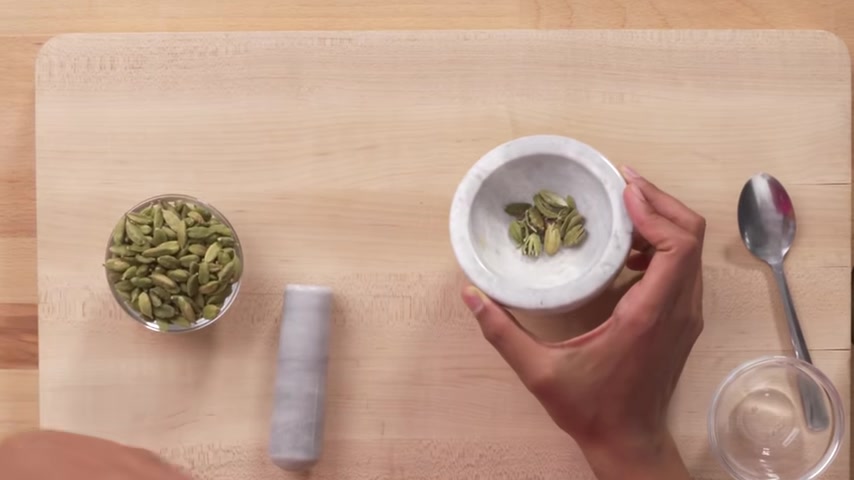
This is the level to which I would smash my cardamom and then I'd let it simmer into my dish .
I would pull out the whole pods before I eat because biting into a whole cardamom pod is never a very fun feeling for times when I do want the full cardamom flavor , I go with the grinder .
It's important to know that the seeds will grind really quickly and finally , but that outer green fibrous membrane that takes a little bit more grinding .
So you want to make sure to really get it .
So it smells really , really minty licorice .
Oh It smells like breath freshener in the most delicious way .
My nose is completely overtaken by how minty piny licorice .
This aroma is cardamom has really serious main character energy .
So that's how you want to treat it .
This is , this is the fruit of the cacao tree getting you from cocoa fruit to cocoa powder is several steps that we can't quite recreate in this space .
We're gonna crack it open .
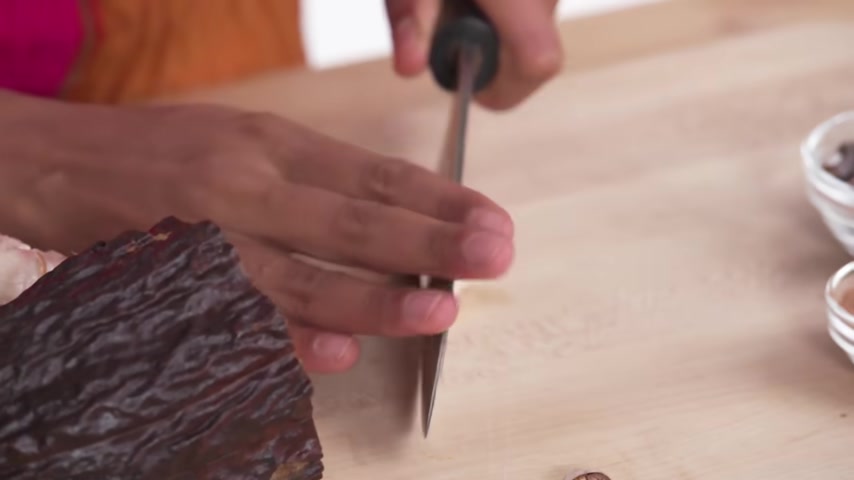
What we're really trying to get to is the center of it , which has the cacao beans or seeds .
So this is the fruit .
This is a kind of member , sticky part of the fruit that's encased around each seed .
I'm gonna cut one open .
These seeds will be fermented and then roasted which will bring them to the cocoa nib form .
These will be ground for a very long time , put through a hydraulic press , taking out as much of the cocoa butter as possible and separating out just the cocoa solids .
All of that processing is what gets you to this ingredient that we all know and love cocoa powder .
What most bean to bar chocolate makers would call the terror of the cocoa powder .
That expression of where it grew and where it came from is that it's very fruity and bright depending on where it's grown .
It can have a huge range of flavors and aromas .
This is sumac in specific , it's Staghorn sumac .
These bright little red berries grow in clusters on the sumac tree .

There are many , many different varieties of sumac that grow all over the world .
What we have here is a Chinese sumac that in Manipur , which is a northeastern state in India is known as wild sumac in color .
It's quite different from the bright redness of the North American Staghorn Sumac .
But they both give you that really zey tart flavor .
We all use sumac for across cultures .
Bunches of the whole sumac berry are clipped off seed to take out any impurities and sediment and then dried so that this is what you end up with whole sumac berries .
These are used in a lot of cultures , but most commonly you're consuming a sumac powder that's had been preserved .
This particular variety is Staghorn sumac .
So you actually take the whole berries and grind them whole .
Then what we have here was ground without the seeds .
The easiest way to grind the sumac is just to stick it in the electrical grinder .
The seeds are pretty tough .
So this is the way we're gonna go .
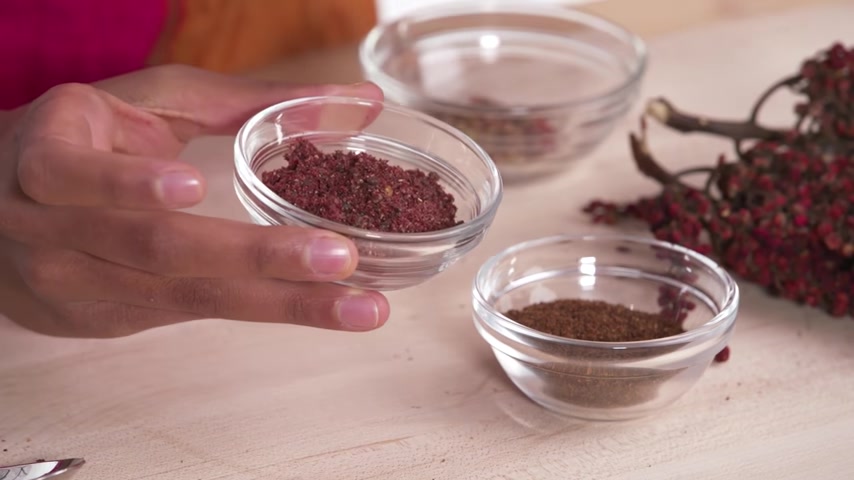
So you can see that this sumac has a much richer kind of darker red than this variety .
In most cases , I would actually see it down so that some of these chunky seeds that didn't break down can be taken out .
Whereas here you'll see we have a pretty fine powder and that's because one , it was ground without the seeds and then it was seed after being ground , but they're both pretty lemony and delicious .
This is a vanilla pod .
It's the cured dried fruit off the vanilla vine .
What we have here is the final cured vanilla pod .
But the process of taking the actual unripe green vanilla fruit and turning that into this little friend can be a curing process that's anywhere from 10 days long to six months .
So inside this kind of fruit casing , there's millions of tiny little vanilla beans and those vanilla beans are really where that vanilla flavor lives .
You could say they look like tiny caviar right now .
I'm smelling plums , I'm smelling prunes .

But when you extract that flavor into either an alcohol or a fat like milk , that's when you get the milder more vanilla flavor .
Only 1% of the vanilla flavors that you're tasting out in the world are actually made from real vanilla beans .
And that's because they're so scarce , they're so expensive .
They're so hard to grow .
Most of what we're consuming on the market is actually fake vanilla flavoring real true vanilla , which is what we have here has many , many more notes .
I always find it funny when people say , oh something's so vanilla because vanilla is actually like a deeply complex like spice that's embattled in , you know , all kinds of global wars .
Um across history , it's anything but vanilla .
This is star Anis .
It's the dried fruit of a small evergreen tree .
It's actually part of the magnolia family .
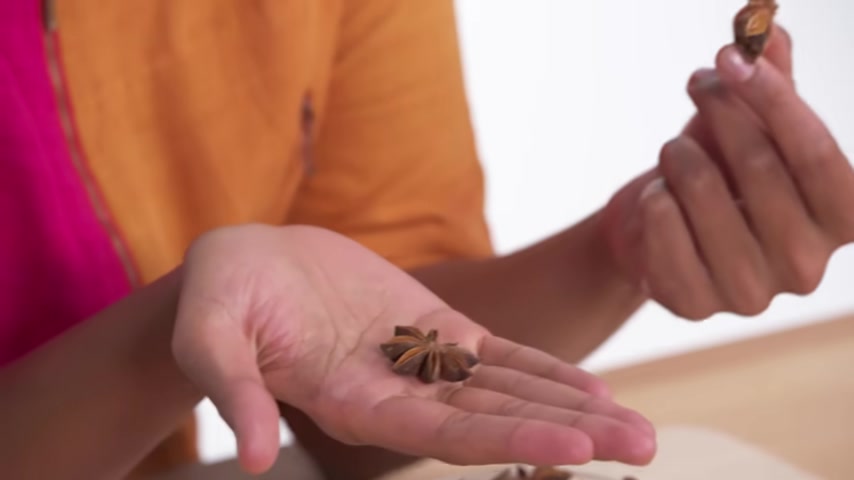
The fruit does have seeds but unlike a lot of other spices , the seed is not where the flavor is with star anis the flavor is in the dried fruit that's dried around the seeds .
So they're picked when they're green and they're ripe .
Um And this brown color develops as they dry and shrink and they add a really kind of delicate licorice flavor to soups to broths .
I love using the Star in this hole , but if you do want to grind it because it's a dried fruit , it's not very hard .
So you can just give it a slight grind and a mortar and pestle .
So that's kind of a lightly ground up or kind of smashed open star an so I do recommend the powdered form of star an for specific Chinese spice blends , but my preference is to use them whole .
Adding star an to a bowl of beef broth is the perfect way to balance out the richness of the meat with the fennel and licorice flavors that it's so known for .
This is garlic .
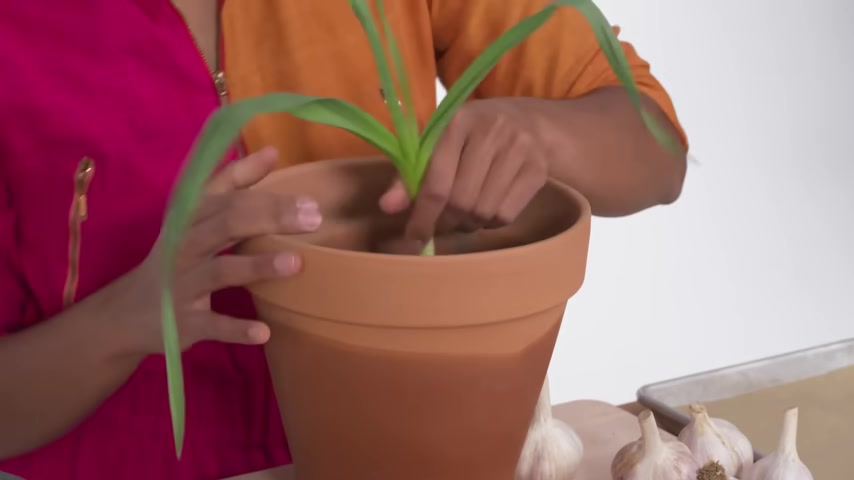
It is the bulb of the garlic plant .
The garlic scapes here , the bulb down here currently it's a young plant .
So it's just a single clove and then this is a root system down here .
So the bulb is where all the nutrients of the plant live , but it's also where the flavor lives , which is why that's the part that we most commonly eat .
But the escapes up here are also really delicious anywhere .
You want a more herbaceous garlic flavor and a grassy garlic flavor .
There's a couple of different ways that we can turn the garlic bulb into garlic powder .
These chips that we have here have been oven baked .
The second method is the method that most farmers around the world are using because it's foolproof and it only relies on the sun .
You're taking these garlic cloves and you're grinding them up to a pretty fine paste , bringing all of the moisture to the surface when you're grinding it .
And that means that there's more surface area from which the garlic will then dry and the moisture will leave the cloves .
So we have some pretty smashed garlic .
What I'm basically gonna do is I'm gonna collect all of that garlic .
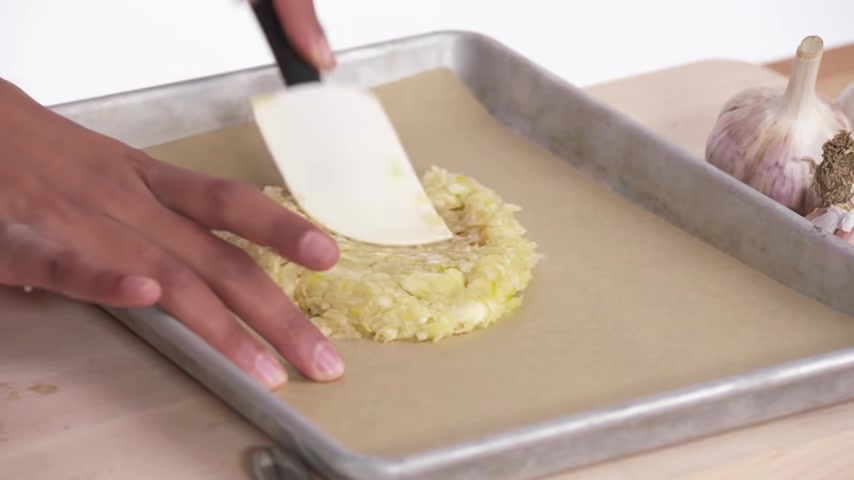
I'm gonna put it onto our sheet pan and spread it out into a disk , making sure to get it really thin .
So this can now sun dry for 2 to 5 days .
You'll know that it's ready to go when it crumbles and cracks very easily .
And you're not seeing any sticky bits inside it whilst that's sun drying for a few days , we're gonna speed things up and use our oven dried chip here , grind those into powdered form .
But we're trying to get a like a really , really fine powder .
See the garlic fumes coming out , that's how fine it's getting .
Resist the urge to grind too much garlic powder at one time as this sits , its oil content is gonna disappear into the air and you're just gonna lose flavor as time goes by .
Whereas right now it's super potent .
I would probably use that much garlic powder to season a whole pot of pasta .
It's actually got a caramelized flavor from the baking process .
So it's not the sharp pungent garlic that , you know , in raw form .
I think the magic of garlic powder is just how convenient it is .
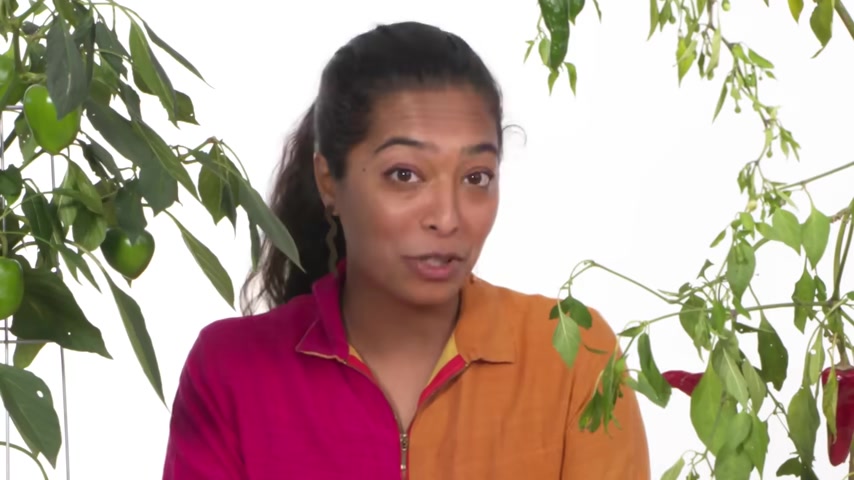
Garlic powder is very democratic and how well you can use it across cuisines , across cultures and it tastes incredible .
So what we have here are chili plants .
You might know them as pepper plants .
When Christopher Columbus landed in the Americas , he was looking for pepper .
What he found and said was chilies .
He didn't know that they were chili so he decided to call them peppers .
Meanwhile , true peppercorns were all the way across the world in India .
We're gonna get rid of our fresh chili plants and we're gonna bring on three different varieties of sun dried whole chilies .
We're gonna start from mildest to hottest .
So the first one that we have here is paprika pepper in particular doesn't refer to a specific chili variety .
Paprika powder can really be made from any mild pepper .
Next up , we have gun to which is one of my favorite chilies .
It is a medium hot chili that's now cultivated on the southeastern coast of India .
Our last pepper here is the ghost pepper or as it's known in Manipur .
The chili .

This is the third hottest chili in the world .
But one of the things I really love about this chili in particular is that it has flavor as well .
It's not just pure heat .
So across the board with whole chilies , I think it's easiest to use an electric spice grinder .
It does the job really well .
And with a pestle , there's more of a risk that you're gonna get some chili particles flying up into your face and I'd like to avoid that Jesus those fumes .
Do you see them ?
I gotta put a mask on .
We're also putting on some sexy safety goggles next up .
We're doing gun tour .
I'm gonna take the stems off because the stems don't have any flavor in them and it just tastes like dirt .
I went ahead and I ground the paprika and the I haven't ground the because everybody in this room would be crying with the paprika .
We've got a really mild sweet powder .
There's a chocolatey flavor .
I smell bell pepper .
I'm gonna take the littlest taste even though it's mild .
So I won't be tasting the other one .

There is a little bit of heat um but it's mostly sweetness .
So paprika powder is really something that you want to use where you want more color and flavor rather than heat next up is it has a tangy fruity flavor .
It's got a ton of floral notes for me to is kind of the perfect chili .
It's an all around because you're getting flavor and you're getting some amount of heat anywhere that calls for a red pepper or a chili flake .
This is my go to our final chili is the ghost pepper or the chili .
We won't be grinding it because it's not really used traditionally in its ground form simply because it is so spicy that the powder would be unusable .
My favorite way to use a chili is to just stick a single chili into a big pot of beans .
I'm talking like a pound of beans .
It imparts this fruity smoky flavor to the rich creamy beans .
The most important thing to remember though , when the beans are done cooking and you're about to serve , you have to take this little friend out .
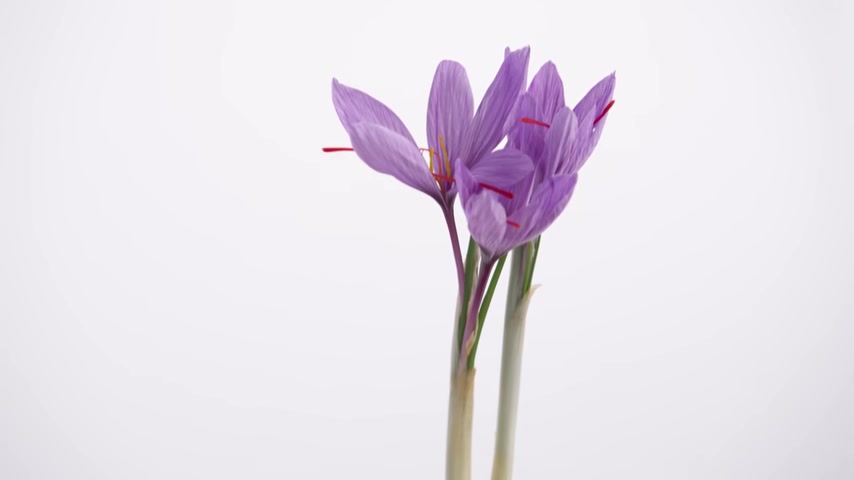
Otherwise it's gonna make somebody's bowl very , very uncomfortable .
This is saffron .
It's the most expensive spice in the world .
These tiny flowers that only bloom one time in the year are harvested and what we really want as the pure saffron , you know , today is the stigma of this flower .
So these little red bits sticking out here and it would actually take thousands of these saffron flowers to produce just one kg of pure saffron .
So what you really want for the purest highest creative saffron is the trumpet shaped tip of the stigma .
That's a deep red that's then dried until it becomes the saffron .
We know this is kind of a final dried stigma whereas this is a fresh stigma .
So this tip will actually be pressed and flatten out a lot more until it becomes this shape and the color shifts .
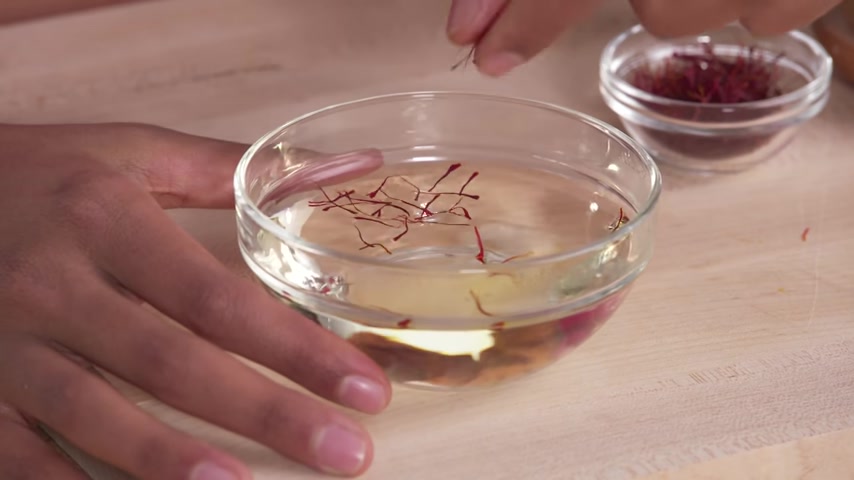
And then if I add this stigma to pretty hot water , the hot water really helps draw out the fat and the color and the flavor out of saffron quickly .
Saffron is actually one of those spices that's mostly fat and that means that it has really high oil content and the oil is what's holding on to all of the aroma and flavor that actually we just two minutes of blooming .
I'm smelling right now .
Dairy and saffron pair beautifully together .
And I think every culture from Italians to , to Iranians to Indians figured that out at some point in some form for really good fresh saffron .
The primary tasting note is actually raisins and kind of dried fruit .
It has this rich fruity .
So this is a slightly wildly generous amount of saffron that we've soaked for about 10 minutes in boiling water .
And as you can see , it has this like sunshine yellow color .
It mells divine .
I'm gonna take a little sip .
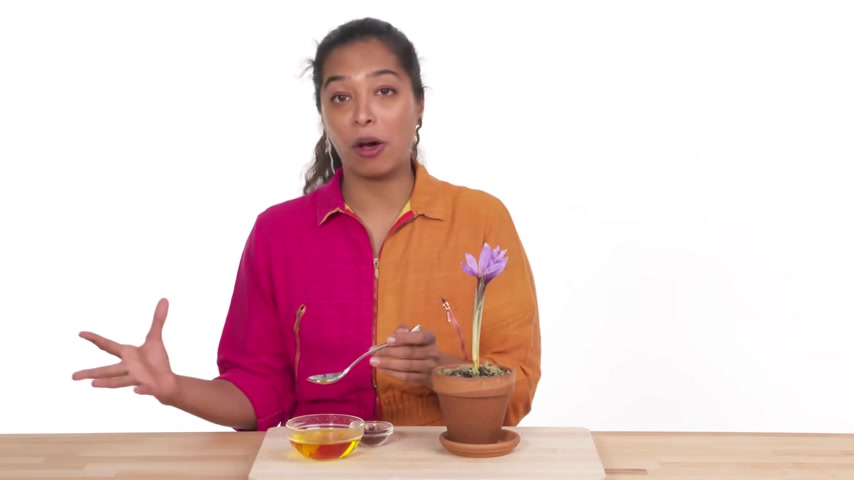
Oh , I think like four teaspoons of that would perfume an entire pot of rice .
So that's really how sparing you could be with your bloom saffron .
These are cloves , cloves are the immature flower buds from the evergreen clove tree .
The bottom is the flower bud stem and then this top head of the clove is actually the clove right before it's gonna burst open into a flower .
Usually the cloves are sun dried and need maybe 4 to 5 days to get to an 8% moisture content so that they have a nice snap and they're not retaining any moisture that could lead to mold .
But at the same time , have the right amount of oil content so that you're still getting all the flavor and the aroma that you want .
The two magic words and spices really are moisture content , which should be and oil content , which should be high .
Um And a good clove is the perfect balance of those two things .

A well dried clove is pretty hard to snap just with your hands and wouldn't do so well in a mortar and pestle though you could give it a go .
Um So I choose to grind my clothes in an electric spice grinder .
I'm gonna do pretty small quantity of cloves any more than this and it's gonna take me months and months to get through it .
You don't need very long in the grinder at all .
So that doesn't create a lot of powder , but it's really , really potent .
I can smell it from a mile pine hena butterscotch .
It's a very balanced flavor , but when you put it in your mouth , it can really overpower .
So even if it smells amazing , you wanna go , you wanna go light on how you use it .
It's really sharp like my tongue is numb officially .
Lots of minty piny notes it is spicy but not obviously in the chili way more in that it overpowers your palate .
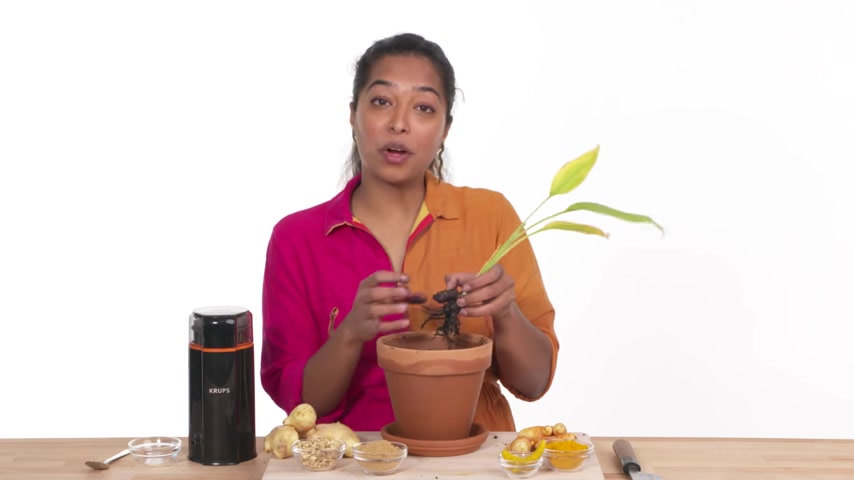
I consider that realm of cinnamon , ginger , cardamom pepper and clove as kind of the trifecta of all fall and winter baking , ginger and turmeric are both rhizomes .
Um The rhizome is the underground stem part of the plant that's then connected to the root .
So it's very similar to bulbs but bulbs are actually modified leaves .
Whereas rhizomes are modified stems .
We're gonna kind of pluck this part off , break it off .
And this baby ginger here is what we know and love and what we eventually turn into the ginger powder that we see right here .
So these polish dried rhizomes are really , really hard cracking .
It is basically impossible , cutting it open would likely dent your knife and grinding it in here is going to ruin your blades .
So these are processed in a very large , very strong industrial grinder to get us to this powder .
It would also usually be received three or four times as a method that's possible to accomplish .
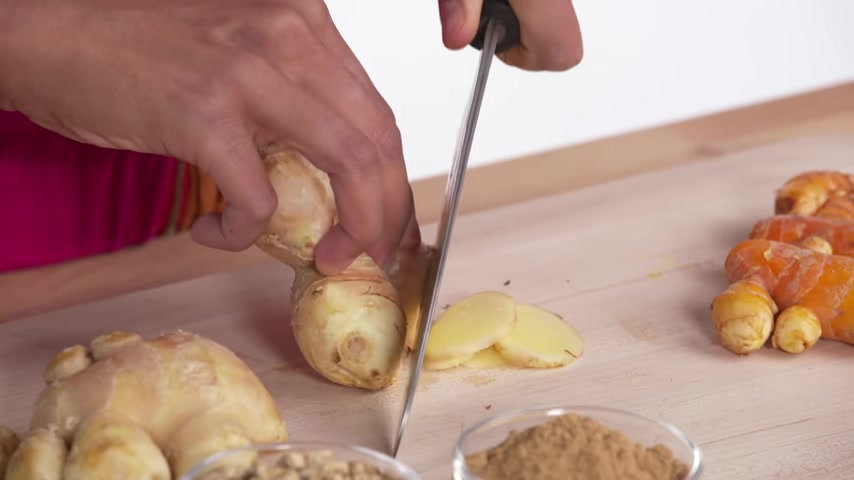
But it is pretty labor intensive .
So it requires slicing your turmeric or your ginger into really thin slices .
You can either sun dry them for two or three days or you could stick them in the dehydrator at which point they'll take about one day .
They're still quite fibrous .
So you'll need to see it .
You're running your powder through a fine mesh strainer and what that'll do is it'll take out your fibrous chunks that you don't want .
You could also chop it up into small pieces like this .
So there's more surface area for the drying turmeric and ginger are actually one of the spices that I don't think you need to grind fresh .
They retain their oil content really , really well in powdered form and they'll last in your pantry for two or three years without losing that oil content .
But it's probably the spice powder with the longest shelf life actually substitute ginger powder anywhere that fresh ginger is required .
But my favorite way to use ginger powder is in ginger cookies .
This turmeric is really sunshiny .
It's really bright .
I'm smelling citrus notes , I'm smelling a little bit of floral .

There's some gold in there growing up in India especially .
We use turmeric in everything from breakfast oats to lunch time to a dinner curry .
That'll add a savory earthy note to anything you're cooking it in .
These are cinnamon .
They are both the inner barks of two different evergreen trees .
This here is cinnamon Veum whereas this here is they're both ground into what people know is cinnamon , but they actually taste quite different from each other .
Cinnamon veri here is indigenous to Southeast Asia , specifically India , Sri , Lanka , Burma Bangladesh in general .
Whereas Kasia is native to China and a completely different tree , much thicker bark , very different color .
You'll notice that cinnamon Veum is lighter whereas Casa has much darker , almost reddish tint to it .
This bark had an outer layer that was shaved off of it .
This inner layer is shaved off into sheets and those sheets are then rolled into quills like this and they're hung up to dry to air dry .
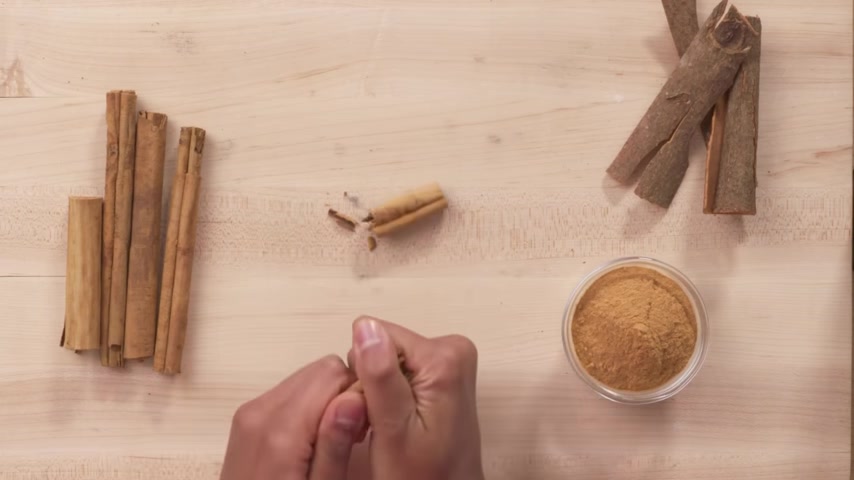
They probably take two or three days to air dry because it's a lot harder .
You can grind it up but you're not gonna get as fine of a powder .
The cinnamon is pretty easy to powder .
So I would just do it in a spice grinder .
It's as simple as breaking this up into a few pieces .
And then we're gonna add that to the grinder .
I would go with the spice grinder just because you're not gonna be able to get a fine powder with a mortar and peel .
So that's our cinnamon powder .
There's a brown butter , there's honey , it's obviously very sweet .
There is a floral fruity note .
So I am getting an orange blossom , orange zest note .
But then of course , there's that sharp spicy finish that we know and love cinnamon for when we're talking about and not cinnamon Veum .
It's much spicier .
It has that classic red hot flavor that you're imagining .
Um And so it plays really nicely with sugar with maple syrup .
It's delicious in pretty much every dessert .
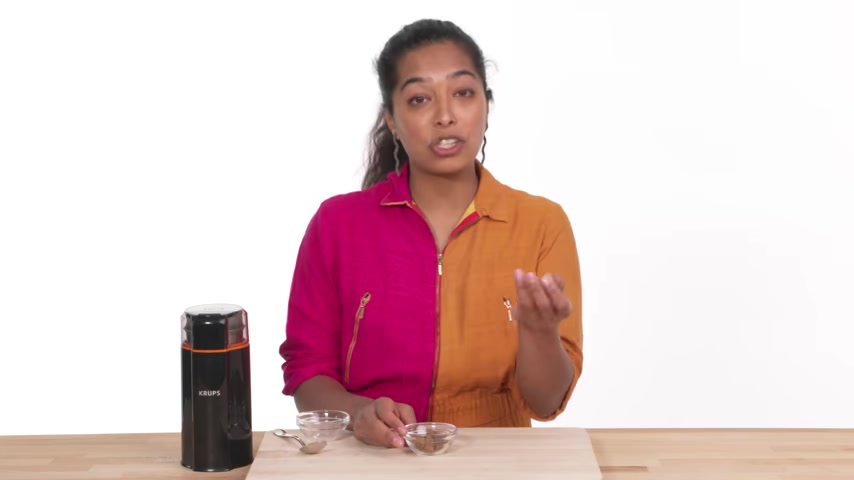
This is a , it is a hard gum like resin that's actually extracted from the roots of the Rila plant plant grows wild in these desert mountain climates , but it's pretty much exclusively used in South Asian cooking to give the flavor of onion and garlic .
So if you're wondering what your Indian or Pakistani food is missing , it's usually this indescribable flavor of a or as I call it in Hindi .
So given that the resin is pretty hard to grind , we're gonna use the electric spice grinder .
So in this very innocent looking bowl , we have our or a powder .
It does have a really really strong sulfuric smell when used in cooking .
The really imparts a allium like oniony garlicky flavor and in a lot of Indian cooking that's very simple or specifically vegetarian .
Um he really has the power to make a dish taste like it's a lot more than the sum of its parts .
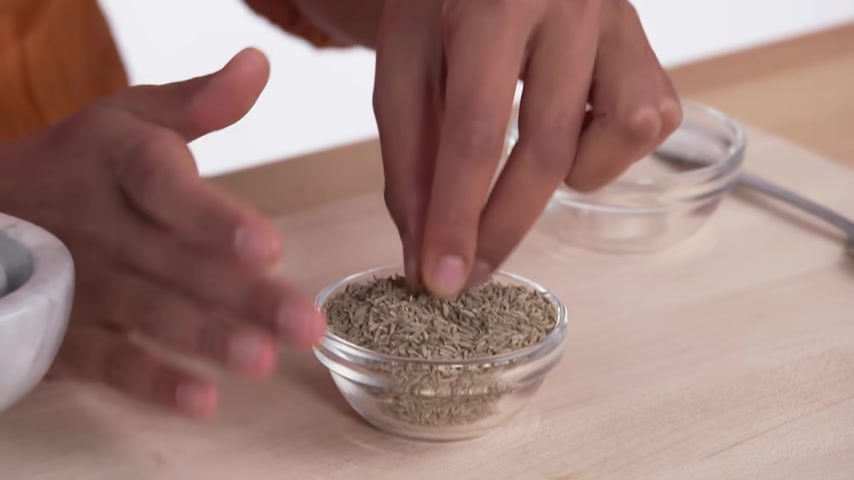
This is cumin , it's the seed of the human plant .
It's pretty delicate but it thrives in hot desert environments .
It's indigenous to Western Asia .
The cumin plant is from the same family as the dill parsley and carrot plants .
Cumin seeds are actually used whole quite frequently .
But cumin powder can be really nice in a spice blend or a marinade .
It's very easy to grind up .
If you are trying to grind a larger amount , the electric spice grinder will work just fine .
Um But for this little handful , the intest is the way to go .
It smells really good .
So all of the oils that were hidden inside that seed have been pounded to the surface .
It's gonna be bringing all of its flavor rather than leaving some on the table .
So cumin is giving you an earthy bitterness .
There's a little bit of licorice in there .
It's adding a very savory note to your cooking .

I often add just one teaspoon of freshly gone cumin to my rice cooker because it adds a really nice smoky earthy note to my rice that I love .
This is coriander .
They are the seeds of the cilantro plant .
Coriander is the name of the seed .
Whereas cilantro is the American name for the leaf .
But a lot of people around the world actually use coriander interchangeably to mean the seed or the leaf .
These leaves will eventually flower and then once we have flowers , those flowers will turn into bright green version of these little seeds that we see here .
Coriander seeds are actually one of the spices that are easiest to grow at home , wait until the plant completely browns .
And at that point collect all of your coriander seeds from the top and you can dry them either sun dried for a few days or in an oven for maybe a couple hours at really , really low heat .
And you'll end up with these lemony zesty coriander .
It's quite a soft seed and really easy to do in a pest .

But if you do wanna do a larger batch , you can go ahead and do it in your electric spice grinder .
So what I'm really tasting is the lemony notes .
Um There's a little bit of nuttiness to it which comes through in the flavor as well as the aroma coriander in its raw form , pears really , really nicely with all forms of citrus .
This is fenny .
It is the seed off the fennel plant .
So once the flower turns to seed and the entire plant has gone to seed , you're waiting for the plant to dry out , which means it's given all of its nutrients to the seed .
At that point , we're harvesting the seed off of the plant .
We're laying them out to dry .
That can either be done sun dried over a few days or you could put it into a low section oven .
You're wanting the seed to go from a bright kind of soft green to this pale brownish green .
That's when you know , it's dried out enough , but it still has its oil content most of the time .
I'm actually using fennel .
Whole in India , fennel is candied in sugar , um and eaten as a digestive .
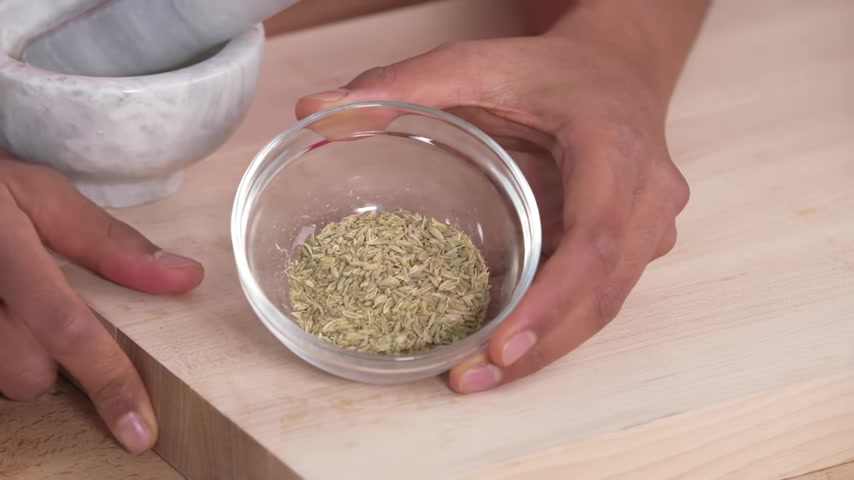
So I grew up thinking that fennel was candy , but especially in Italy cooking fennel pears really , really nicely with pork .
And at that point , I do like to lightly smash it .
All I wanted to do is release a little bit of the oil so that you're getting as much flavor as possible .
But I still want the texture and the crunch of the whole fennel , the kind of sweet licorice notes that you're getting from fennel , cut through the richness of pork really really nicely .
Mustard .
Seeds are seeds that come from the mustard family .
The mustard plant has many different varietals .
One varietal can produce yellow mustard .
Another varietal produces black mustard .
But when you actually look at the plant , not the seeds , they might look very similar .
But the seed variety produces really different colors of the two different varieties .
Yellow mustard is much sweeter .
There's notes of maple , there's notes of nuts whereas the black mustard is much sharper and more pungent .
Um And it really has that distinctive brassica edge to it .
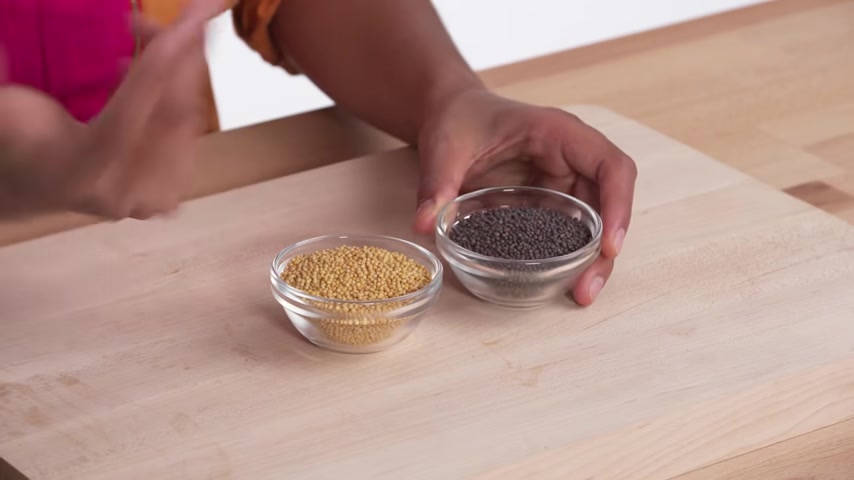
Black mustard seeds are traditionally just used in their whole form .
Similar to sesame seeds .
They add that texture of crunch in whole form , especially when they're fried .
They really add a nuttiness to your cooking .
Whereas yellow mustard is traditionally powdered , smells like cooked Brussels sprouts in a way , it's quite soft .
Then when I'm tasting it , it's a really sharp hit of mustard .
Um It's very pungent , it's quite spicy at the back of my tongue .
Um So it is a good lesson that spices can smell one way and then taste a completely different way .
So if you did want to turn yellow mustard into mustard , the condiment , all you really need to do is grind the yellow mustard seeds with a little bit of water , some vinegar , some lemon juice , probably a little bit of salt .
Um until you get that thick consistency and you have fresh mustard .
So the most traditional use for black mustard seeds are toasting them in a fat , which is called , it's a process of blooming the spice that also gets the mustard seeds really crispy and toasty .
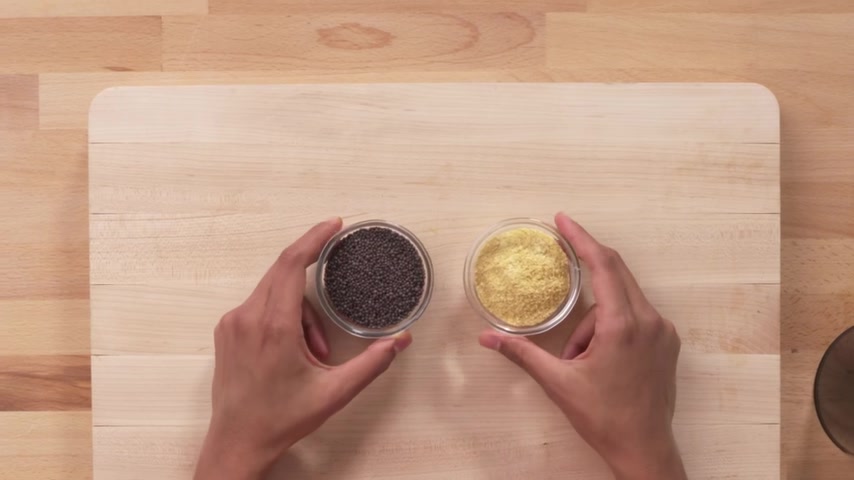
And that makes a beautiful garnish on pretty much anything .
I add it on top of my dolls or my vegetables , whether it's yellow mustard or black mustard , adding mustard seeds is just a really nice way to add a sharpness and a pungency to pretty much any dish .
Now that you've seen how almost every spice goes from plant to pantry .
My hope is that it really inspires you to use these spices with a lot more confidence and honestly just have a lot more fun with them .
Understanding where spices come from is a really important part of connecting with foods of different cultures and really driving home the point that flavors connect all of us .
Are you looking for a way to reach a wider audience and get more views on your videos?
Our innovative video to text transcribing service can help you do just that.
We provide accurate transcriptions of your videos along with visual content that will help you attract new viewers and keep them engaged. Plus, our data analytics and ad campaign tools can help you monetize your content and maximize your revenue.
Let's partner up and take your video content to the next level!
Contact us today to learn more.